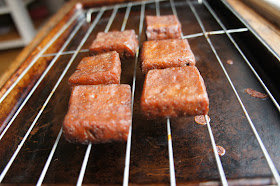“Jun” means “pan fried” in Korean. Different types of pancakes and pan-fried patties are often served as side dishes in Korean meals. In the old days, juns were only served to the royal family as a banquet food because they are pretty labor intensive. Juns are often filled with assorted vegetables, seafood and meat. Nowadays juns are not just for the royal and the wealthy, but they’re still mostly served during special occasions such as weddings, birthdays and New Year’s. Just like Japanese temporah, you can pretty much jun with anything you like.
My mother is currently visiting me here in Maine and she has been having all kinds of fun using local ingredients through-out the season to make Korean and Chinese food for us at home. And what better ingredient than squash to cook with during the fall season?
This week I’d like to share with you my mother’s recipe for squash pancakes — Dan Hobuck Jun.
Ingredients:
- (serves 3 to 4 people)
- For the pancake:
- 1⁄2 acorn squash
- 1 scallion
- 1 cup flour
- 1 cup water
- 2⁄3 tsp. salt
- oil for pan frying
- For the dipping sauce:
- 3 cloves garlic
- 2 scallions
- 1 Tbsp. minced ginger
- 1 Tbsp. hot pepper flakes
- 1 Tbsp. sesame seeds
- 5 Tbsp. soy sauce
- 2 Tbsp.+1 tsp. rice wine vinegar
- 1 tsp. sesame oil
Directions:
Peel and cut the acorn squash into thin sticks. Slice the scallions into thin strips too. Then toss both into the batter and make sure everything is well coated.
In a large non-stick skillet on low heat, drizzle a little oil in the pan and drop in the batter — about 2 Tbsp.of batter for each pancake. Let them cook for 8 to 10 minutes on one side before you flip them. Cook until both sides are crispy and golden brown.
You can prepare the dipping sauce while you are waiting for the pancakes to cook. Mince garlic, ginger and scallions into small pieces, and mix all ingredients together in a bowl.
Once the pancakes are done, serve them with the sauce.
These make great banchan (side dishes) or enjoy them on their own!







































